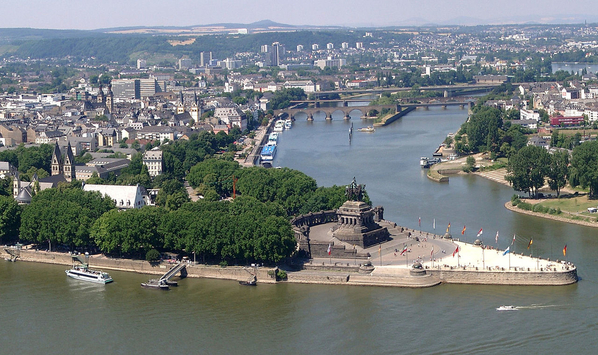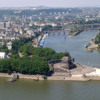Koblenz, at the meeting of the Rhine and Moselle, is home to the German Corner, the point of land between the two rivers. That may be a bit ironic, because over two thousand years Koblenz managed to be under the hand of Romans, Vikings, Franks, Swedes, Russians, French and a wide variety of minor princelings as well. 'Change' certainly fits a discussion of Koblenz!
Koblenz's History Fountain tells the town's tale from Roman times to today.
The 'corner' has played a symbolic role in German unification—twice. In 1897, it became home to a huge (37 metre) statue of Kaiser Wilhelm I, who completed the unification by force and wile of all the individual German states into one empire. It was destroyed in World War II, and until 1993 had a German flag instead of a statue, and was dedicated as a monument to peace and unity. A new copy of the statue was installed in 1993; some remain dubious of the motivation.
Just around the corner, as it were, from the German Corner, is Koblenz's oldest church, the Basilica of St Castor, with its unusual 12th century towers masking a church whose vaults and crypt date to the early 9th century. In 842, after several years of war and disputes among Charlemagne's heirs, over a hundred representatives of his sons and grandsons gathered in the church to make peace and take pieces of the empire.
It's a far more peaceful scene today, and the grounds are home to a number of well, interesting, works of art.
A quiet corner along the Moselle side as we walked into the center of the Old City, or Altstadt... and the German equivalent of the Goodyear blimp, high overhead. Yes, it's actually a Zeppelin, and the initials ZF are for the Zeppelin Foundation, a charitable trust that owns the company that makes the blimps.
On the left, a large memorial for a former state president; on the right a smaller one that commemorates the Roma and Sinti residents of Koblenz who were sent to concentration camps by the Nazis and murdered there.
Old and new sections of this hotel, named for the German emperor, are linked by a clever trompe l'oeil. Many of the older buildings, like those below, have interestingly decorated facades, and many are reconstructions; Koblenz was heavily damaged in the war.
At St Florin's market, a group of four historic buildings mark the old commercial center of the city; you wouldn't know at a glance that they, too, are reconstructions replacing originals that burned in 1944 and were only rebuilt in the 1960s. Among the reconstructed items was the Augenroller, or Eye Roller.
Placed just below the town clock on the facade of the Merchants and Dance Hall, the knight with the notable eyes is reputed to represent a 16th century brigand, Johan Lutter, legendary for his defiance of authority and his escapes. When finally sentenced to death, he mocked his jailers and made faces, sticking out his tongue and rolling his eyes at the executioner. Some legends say he kept on doing that after his decapitation. At any rate, the eyes swivel back and forth with the clock's pendulum, and on the quarter hours, his red tongue sticks out.
The Liebfraukirche's onion domes are a reminder of other styles; they are more typical of Bavaria than the Rhineland.
The facade of the Liebraukirche (Our Lady Church) bears her image; on the ground nearby, a more recent artwork, calling for peace and unity among peoples in the name of the 'Angel of Cultures.'
And a gorgeous set of doors.
Not all the facade decorations to be seen in the city are in historical styles; these verge on the psychedelic! And, there's also some whimsical statuary on display.
Just possibly, though, the ultimate whimsical sculpture is probably this improbable statue, actually a fountain, that spits water at passers-by at irregular intervals and depicts boyish mischief of various kinds on its base. It's the Schängel Fountain; the name comes from a local corruption of the name Jean, once a common one in Koblenz after rule by France.
Although the statue only dates to 1940, it's become such a symbol of the city that it's reproduced on the city's manhole covers!
Just an archway away from the spiting boy is a building that's now shared between the town hall and a school, but was once a monastery and school operated by Jesuits, who left their name on Jesuitenplatz, even after the order was banned in the 19th century.
Its religious connection is made even clearer by its junction with the next-door church that was, and is often still called, the Jesuit Church. Behind its traditional and severe looking facade is a wonderful modern church that was built to replace the original that stood behind the facade and was destroyed in World War II.



Comments (0)